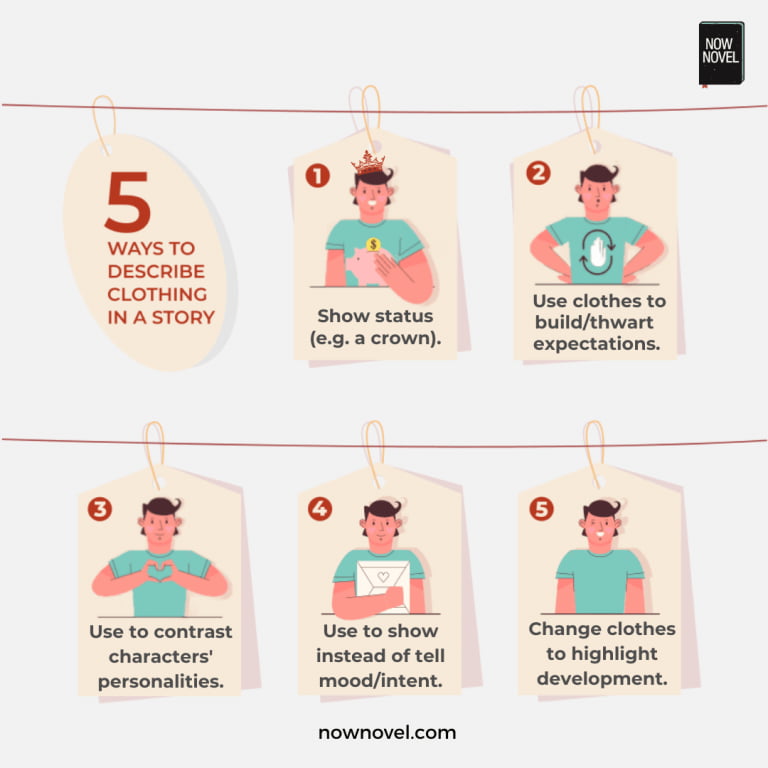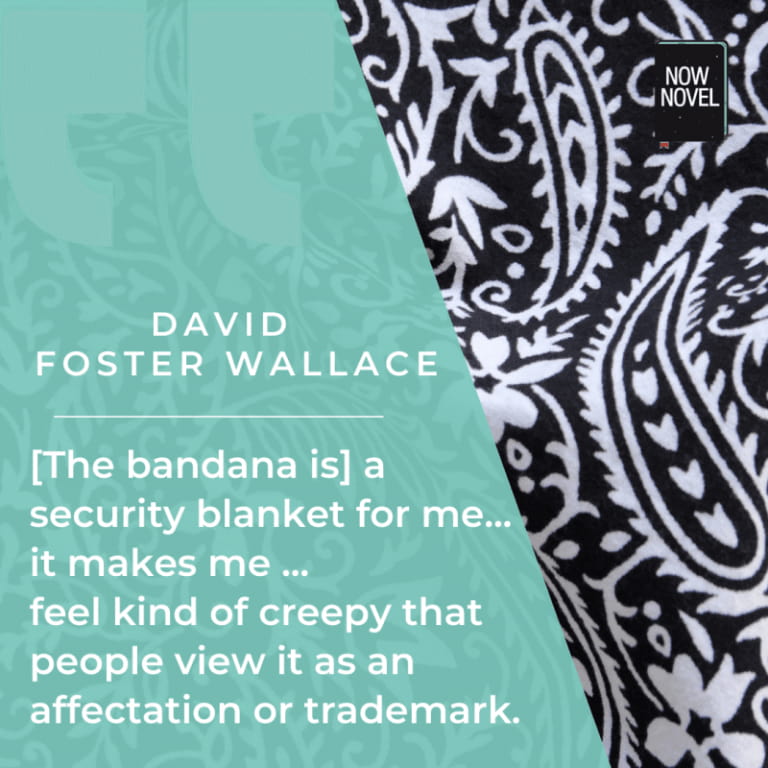The clothes a person wears tells us many things: their status in life, for example, or their cultural affiliation or identity. They can tell us what era they live in, and even a person’s current state of mind or intent. Understanding how to describe clothing in a story well will help you create fuller, richer character portraits.
How to describe clothing: 6 simple tips
- Use clothing to show status and position
- Build (or thwart) expectations using clothing descriptions
- Describe clothing to contrast character personalities
- Show clothing to avoid over-relying on telling
- Change clothing to highlight character development
- Use clothing details to create authentic setting
Let’s delve further into these ideas about describing characters’ dress:
1: Use clothing to show status and position
Think of your characters’ clothing like an actor’s costume in a play.
Costume is a large part of a character. As soon as the actor enters stage right or left, we have an inkling of whether they’re a wealthy landowner or peasant, an elegant heiress or humble flower-seller.
In Gabriel Garcia Marquez’s Love in the Time of Cholera (1985), we learn of a doctor’s status through his being the only person at an event who is not smartly dressed:
Although it was not customary for invitations to request special attire, least of all for a luncheon in the country, the women wore evening gowns and precious jewels and most of the men were dressed in dinner jackets with black ties, and some even wore frock coats. Only the most sophisticated, Dr. Urbino among them, wore their ordinary clothes.
Gabriel Garcia Marquez, Love in the Time of Cholera (1985), p. 35.
What the description shows is that many of the invitees play at status through fancy dress. Yet Dr. Urbino’s status as a respected doctor is earned – he has nothing to prove by dressing smarter. Thus his plain dress is, ironically, indicative of higher status.
Like Marquez, compare and contrast character’s clothes to reveal important details about their social status or position. You can weave clothing description into your process when using our story planner for writers.
2: Build (or thwart) expectations using clothing descriptions
You can quickly convey a number of things about your characters based on the clothing they wear. You can also fulfil (or contradict) impressions your characters (or readers) form based on appearances.
Tweet This
For example, think about a wealthy person and how that person might dress.
You may have imagined a man in an expensive suit or a woman in designer clothes. You can immediately show a character is wealthy with descriptions of fine clothing. However, you can tell your reader interesting things through a mismatch:
A wealthy character might show off their expensive clothing. But they could also dress in modest, inexpensive-looking clothes.
What would you think about a wealthy character who looked as though he shopped at thrift stores? Or one who was forever wearing poorly-fitted clothing that appeared to be handed down from friends?
These detail could suggest that your character is miserly or down-to-earth despite their wealth. Dr. Urbino in Marquez’s example above fits the latter category.
Let’s have a look at this description in The Great Gatsby by F. Scott Fitzgerald: ‘Gatsby, in a white flannel suit, silver shirt, and gold-colored tie, hurried in.’
Gatsby’s extravagant and meticulously chosen attire reflects his wealth and the opulence of the Jazz Age. The details about his clothing contribute to the overall image of him as a mysterious and wealthy figure, obsessed with appearances and the trappings of success.
Think of other interesting combinations: A teacher who dresses provocatively; a beggar with an innate sense of style. What backstory or character motivations could combinations of appearance and reality suggest?
Make a Strong Start to your Book
Join Kickstart your Novel and get professional feedback on your first three chapters and story synopsis, plus workbooks and videos.
Learn More
3: Describe clothing to contrast characters’ personalities
A few small details of clothing may distinguish your characters from each other, highlighting their personalities.
The Victorian author Charles Dickens is widely regarded as a master of characterization, for good reason. His writing offers a masterclass in how to describe clothing in stories.
Consider this example from Hard Times. See how Dickens contrasts the fact-obsessed, overbearing teacher Thomas Gradgrind and his wife’s personalities through (among other details) their clothing description.
In this scene, Gradgrind returns home to find his children playing outside:
A space of stunted grass and dry rubbish being between him and the young rabble, he took his eyeglass out of his waistcoat to look for any child he knew by name, and might order off.
Charles Dickens, Hard Time (1853), p. 15.
The bully Gradgrind is the type who’d wear a waistcoat concealing an eyeglass for catching people out.
Compare this, then, to Dickens’ description of Gradgrind’s wife in the following chapter (Gradgrind’s wealthy but poverty-claiming friend has just told Mrs. Gradgrind he was born in a ditch):
Mrs. Gradgrind, a little, thin, white, pink-eyed bundle of shawls, of surpassing feebleness, mental and bodily; who was always taking physic without any effect, and who, whenever she showed a symptom of coming to life, was invariably stunned by some weighty piece of fact tumbling on her; Mrs. Gradgrind hoped it was a dry ditch?
Dickens, p. 19
In one single piece of clothing description (‘a pink-eyed bundle of shawls’), Dickens conveys how timid and ailing Mrs. Gradgrind is in contrast to her bullish, overbearing husband.
Similarly, in The Girl with the Dragon Tattoo by Stieg Larsson, we read:
Armansky’s star researcher was a pale, anorexic young woman who had hair as short as a fuse, and a pierced nose and eyebrows. She had a wasp tattoo about an inch long on her neck, a tattooed loop around the biceps of her left arm and another around her left ankle. On those occasions when she had been wearing a tank top, Armansky also saw that she had a dragon tattoo on her left shoulder blade. She was a natural redhead, but she dyed her hair raven black. She looked as though she had just emerged from a week-long orgy with a gang of hard rockers.
Salander’s tattoos, including her iconic dragon tattoo, the dyed hair and the fact that she looks like she’s been with a gang of hard rockers show us her rebellious and unconventional character.
Similarly, show how different characters’ personalities are through apt clothing description.
[Find more articles on character description in our complete guide to character creation.]
4: Show clothing to avoid over-relying on telling
Clothing description in a story is useful because it often gives additional information about a character that you might otherwise tell.
For example, if a character is going on a date, you could write:
Gem wanted to look sexy for her date downtown (but not easy), so she changed into more comfortable clothes.
However, you can show and imply a character’s intention without spelling it out:
They’d agreed to meet downtown at six. At a quarter to six, Gem pulled off the low-cut top Emma had wolf-whistled and clapped at when they’d met for their usual weekend catch-up. ‘Make them earn any sight of skin,’ Aunt P always said. Jeans and a tee it was.
Why this arguably works better is the details of getting dressed tell us multiple details about Gem.
The last minute change suggests an indecisive nature. We see the contrast between the character’s friend’s reaction and the advisory words of Gem’s aunt. The fact Gem goes with jeans and a tee could suggest that she trusts her aunt’s advice. Or else that she feels shamed by her Aunt and thus decides to ‘be good’.
There is simply more characterization, not only of Gem but the other characters, too.
Meanwhile, in The Devil Wears Prada, the first chapter immediately shows us that the first-person narrator, Andrea, pays close attention to fashion. We learn more as the novel continues. Here’s the excerpt:
I had a few seconds … to pull off my Manolos and toss them into the passenger seat. There was nowhere to wipe my sweaty hands except for the suede Gucci pants that hugged my thighs and hips so tightly they’d both begun to tingle within minutes of my securing the final button. My fingers left wet streaks across the supple suede that swathed the tops of my now numb thighs
5: Change characters’ clothing to highlight character development
Changes in characters’ clothing can help reveal character development. Character description may change over the course of a story to emphasize a character’s arc.
In Dostoyevsky’s Crime and Punishment, the poor, Tuberculosis-stricken Katerina Ivanovna’s husband is trampled to death by a horse-drawn cart.
The novel’s protagonist Rodion gives Katerina the last of his money to host a funeral. Dostoyevsky describes how Katerina’s landlady, Amalia Ivanovna, dresses for the funeral:
…the table was properly laid at the time and fixed, and Amalia Ivanovna, feeling she had done her work well, had put on a black silk dress and a cap with new mourning ribbons and met the returning party with some pride. This pride, though justifiable, displeased Katerina Ivanovna for some reason.
Fyodor Dostoyevsky, Crime and Punishment (1866), p. 340.
Katerina is affronted by Amalia’s fine dress because it is ‘new’ and shows ‘pride’. Impoverished with children to care for, she uses her last money to give her husband a dignified funeral.
Amalia’s dress thus comes across as insensitive to her; malicious even. The landlady’s dress highlights, by contrast, the downward spiral of Katerina’s fortunes, and she responds to the landlady’s prideful clothing with her own wounded pride:
Look at her, she’s making round eyes, she feels that we are talking about her and can’t understand. Pfoo, the owl! Ha-ha! (Cough-cough-cough.) And what does she put that cap on for? … Look how she sits with her mouth open! An owl, a real owl! An owl in new ribbons, ha-ha-ha!
Dostoyevsky, p. 343.
Embarrassed by her own inability to dress in finery for the occasion (and by being upstaged), Katerina resorts to scathing mockery of Amalia.
Like Dostoyevsky, think how something as small as a character’s change of clothing can affect their own or others’ behaviour.
6: Use clothing details to recreate authentic setting
Another important function of clothing description in stories is to create an authentic sense of time and place. Particularly in genres such as historical fiction and fantasy, clothing can help to create other worlds (or a long gone era of our own).
Here, for example, Hilary Mantel describes a Cardinal’s residence being plundered by the King’s men in 1529 England, in her historical novel Wolf Hall. Mantel describes the cardinal’s vestments:
They bring out the cardinal’s vestments, his copes. Stiff with embroidery, strewn with pearls, encrusted with gemstones, they seem to stand by themselves.
Hilary Mantel, Wolf Hall (2009), p. 49.
Mantel creates a vivid sense of the wealth that the church amassed in these times. The fact the clothes ‘seem to stand by themselves’ indicates just how heavy they are with jewels and embroidery.
The details create an authentic sense of a prominent cardinal’s dress in the 1500s.
Elsewhere, Mantel’s novel is full of descriptions of garments for specific, era-appropriate purposes: Riding cloaks, town coats, and other clothing people of means would have worn at this time.
The same set of details are present in Ken Follett’s The Pillars of the Earth in the following extract:
Tom lifted her easily, and set her down gently on his cloak.
He knelt beside her. The wool tunic she was wearing underneath her own cloak had buttons all the way down the front.
By using the words ‘cloak’ and ‘wool tunic’ we are immediately catapulted into the 12th century world of this novel in this description of clothes.
Similarly, find out (or, if you’re creating a fantasy world, create) the garments your characters would wear in a particular time and place. Use fashion and clothing history archives if necessary. Describe these in passing to add visual colour and authenticity to your character descriptions.
Ready to sketch vivid characters for your novel? Use the ‘Character’ section of the Idea Finder to develop quick story ideas and flesh out your story’s cast.





20 replies on “How to describe clothing in a story (with examples)”
I used to be under the mindset that describing attire was boring and it was better to let the reader fill in those details… but especially with the novel I’m working on now, I have used clothing to portray more about their character. So this really reaffirmed that approach for me. You really can tell a lot about a person by what they wear, or what they don’t wear.
True, it all depends on your purpose. Subtle clothing changes can signal character development quite effectively in some scenarios.
This article was very helpful…can you post some examples of showing versus telling when describing clothing? Thanks I will be following your blog from now one I just came across it today.
Thanks Liv, I’m glad you found this helpful. As for showing with clothing rather than telling, a writer could say, ‘He was lazy and inattentive to his appearance’ about a character, or they could say ‘his clothes always looked like he’d just pulled them out of a pile in some corner of his bedroom and had thrown them on without a glance in the mirror’. You can use visual description to make a character more vivid in the reader’s mind’s eye.
I love the way clothes can describe a character. I saw Jesus Christ Superstar a long time ago and ‘Jesus’ was in a sharp black suit. Which was, indeed, a little weird straight off! But as the show moved forward the suit got more ragged – the jacket was open, then gone, the shirt cuffs undone, half the buttons undone and I think by the end when he was on the cross the shirt was gone. Such simple things, but the clothes really helped show Jesus’ plight. Our characters are always (mostly!) clothed and we should definitely be using them to portray our characters’ personalities. Love this topic!!
Thanks, Teresa, and for sharing that great example from the stage. That’s a good example of using clothing to reinforce the narrative of a character’s arc.
I really loved this article, but I have one question, it was very helpful.
What is a good way to do “Show not tell” in a first person POV state?
Hi Paige, thank you (and thanks for your question). One way is to avoid what we call ‘filter words’. Instead of saying, for example ‘I saw that the station gate was coming down and the last train was about to leave’, you could say ‘The station gate is already screeching closed. The train hums and throbs in place as people rush to pile in.’
Use your first-person narrator’s senses – sight, hearing, touch, etc. That also will help readers really experience things through their eyes.
Thank you so much this really helped.
What I would like to ask is how you would go about describing very specific details on more complex clothing? Like say a vest with mirrored sequins and rhinestones, but they all go in a pattern and you feel the need to describe the pattern line by line?
In my case my character is new in town and this description of clothing doesn’t come until he’s getting ready for the party in chapter 4 and it’s in the context of getting dressed, there are reasons behind it, the party is a very big deal for him getting his foot in the door with other teens in town and he wants to be impressive or maybe wants lot of attention with all the sparklies. Also his mother was poor and anyone who knew that might wonder how he could afford such clothing so it hints at the actual story.
Normally I don’t dress characters with such complex clothing that takes more than a few sentences to describe but the vest was inspired by a picture I saw and it took at least a paragraph to describe.
What also worries me is that in Chapter 3 I used a lot of descriptions of the house, like the main characters room and then I had him go to various other rooms, looked at pictures of his family he has yet to meet so chapter 3 had the least story development or social scenes but the ones it had were good ones and I ended it with a scene that creates more development and story hype.
Chapters 1 and 2 were pretty decent and I started chapter 4 with him dressing for the party. I thought if I did that at the beginning of a chapter it would be better but I worry it will turn readers off. It’s a bit OCD of me.
I didn’t even know how to begin describing this piece of clothing. The fact that
it’s obviously black with a centered zipper is easy but then the various pieces, the shapes, the colors, like two rows of this then a row of that, you get what I mean? Or is it really important for a reader to know the specific pattern?
Look at this picture, is it insane for an author to try to describe this on a character? https://uploads.disquscdn.com/images/e7bbcc198c936bc1af3fbda128514c44fcfc10f0513ea31cad7c21ae61ba0ab0.jpg
I will try to be a doctor.
Good luck, I hope you achieve your goal.
Very informative. Really like your article.
Thanks, Sana. Thank you for reading our blog!
When describing clothing in a story, consider using it to show status, position, and character background. Clothing can also be used to build or contradict expectations and contrast character personalities. Avoid over-telling by showing clothing details rather than relying on telling. Use changes in clothing to highlight character development and use clothing details to create an authentic setting.
Hi Varsham, thank you for sharing these tips and for reading our blog!
I love how you break down complex concepts into easy-to-understand terms. Your ability to simplify things without compromising on quality is impressive.
Hi Ranit, thanks for your kind feedback. I’m glad you found this easy to understand.
This post is a lifesaver for aspiring writers like me! Describing clothing has always been a challenge, and these examples make it so much clearer. I can already imagine my characters’ outfits coming to life in my next story. Thank you for breaking down the process and providing such helpful tips!
Thanks for writing in. It’s good to know that it was helpful!